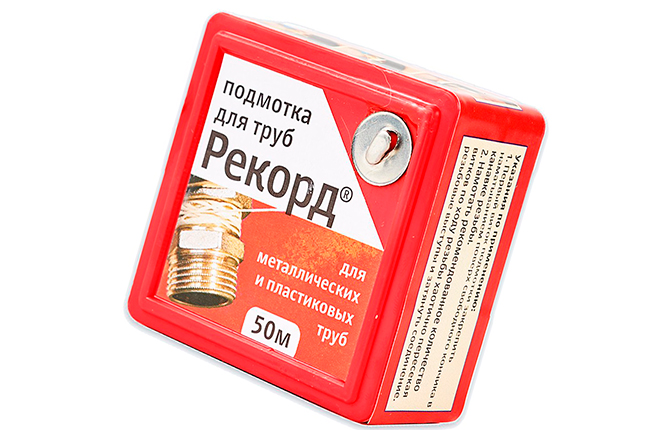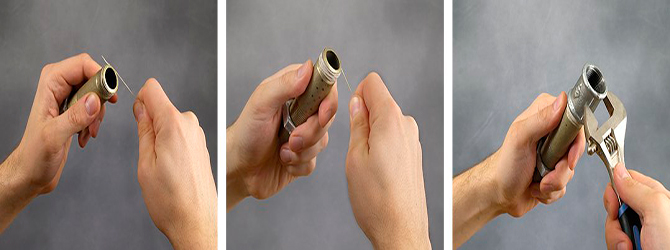Rewind for pipes "Record": new technologies for sealing threaded connections
For the construction of utilities today, non-metallic pipes are predominantly used, but plastic ones. But still, threads continue to be used in pipelines and heating systems to connect sections to each other. Therefore, for their greater sealing, different materials are needed - from traditional to synthetic tapes. Record pipe winding is a polymer-based thread impregnated with substances with sealing properties. Refers to the latest generation of seals.
The content of the article:
Why you should choose Record pipe winder
Previously, flax strands were used as thread sealant. This material was prescribed in SNiPs. But in practice it is difficult to apply. A person must have some experience in plumbing to properly use flax strands. There is also another disadvantage - if the flax is wound incorrectly or is not sufficiently impregnated, then the required level of sealing of the pipes will not be achieved.
The Record pipe winder can be used to seal engineering systems for any purpose. It is important that for an effective connection, the thread must be made externally, while on fixed fittings and pipes it must be internal. Hidden will not work.
Scope of application for Record pipe winding
Winding can be useful in many situations - from standard installation of a utility network to eliminating an emergency leak. It can be used if you do not have the skills to carry out plumbing work.
The sealant is suitable for sealing pipelines that supply:
- water for drinking;
- gas;
- compressed air;
- water for domestic needs.
Advantages of winding for pipes “Record”:
- installation is carried out even in non-standard conditions - on wet threads or at low temperatures;
- no additional preparation required. Polymer thread "Record" is sold in a box, complete with a small knife for cutting;
- maximum sealing of joints of engineering systems;
- the polymer thread does not contain harmful components that could cause allergies in humans when working with it;
- The product is certified for use in pipelines and heating systems.
In the event of a leak, using a winder will help quickly cope with the accident. You can wind it up very quickly. At the same time, the polymer thread itself is resistant to vibrations and changes in temperature conditions.
Why "Record"
Polymer thread is suitable for sealing pipes and fittings made of any materials - be it steel or plastic. It is allowed to be used for sealing heating systems, pipelines for water and gas supply.
“Record” pipe winding is a polymer thread with a flat cross-section, impregnated with substances with sealing properties. It contains no chemicals that can pollute or absorb water. The thread can withstand sudden temperature changes and is not afraid of increased pressure. The sealant also has a SEZ for use in water pipelines.
Operating temperature – from – 60 to +120 °C. It is easy to seal the joints of the pipeline, and if necessary, removing the seal is also not difficult.
Advantages of Record pipe winding:
- polymerization in a few seconds;
- Possibility of installation on wet threads;
- the thread does not swell under the influence of moisture and does not collapse;
- it is convenient to carry out installation - even a person with minimal knowledge of the specifics of plumbing work can handle it;
- protects pipes from corrosion;
- affordable price – from 220 rubles.
Material consumption is shown in the table below.
Step by step use
Record pipe winding can be used to seal wet, partially damaged and rusty pipeline connections. But before carrying out work, the surfaces must be cleaned of dirt.
The end of the thread is wound closer to the edge of the fitting in the groove in the direction of the thread. Next, the turns lie crosswise. It is important that the center of the sealing material is thicker than its edges. After winding, the pipeline parts are connected. If part of the winding is squeezed out, the work was done poorly. You should disassemble the connection again and rewind the thread.
Instructions:
- The starting turn is secured with overlapping.
- The sealant is wound through the threaded projections with a slight overlap. For standard pipes, 5-6 turns are enough. For products with larger diameters, this number increases.
- The winding should be tight and not move.
- Twist the connection. If the thread is squeezed out, it is disassembled and the seal is screwed on again.
- The final stage is to adjust the joint to an angle of up to 180°. This will not affect the seal.
Where can I buy
The product can be purchased both in regular stores and on online platforms. The price starts from 200 rubles for 50 meters. Usually this amount is sufficient to seal all pipeline joints, since the material is consumed sparingly.
The Record seal is a new product on the market that is suitable for maximum sealing of heating systems and pipelines for various purposes. Produced in compliance with international standards and GOSTs. There are no dangerous chemical compounds in the composition.
What sealant do you prefer to use? Write in the comments. Save the article to bookmarks and share it on social networks.
Rewind for pipes Record. Instructions for use in the video.







